Volcanoes have been prevalent throughout history, and Hawaii, in many historical events. Active volcanoes are either spewing lava or could potentially erupt at any moment, while dormant ones are at rest. It’s spectacular how volcanoes grow over time and how their lava can form landmasses. The islands that make up the U.S. state of Hawaii were all created by volcanoes. Just how many volcanoes are in Hawaii?
Volcanoes in Hawaii
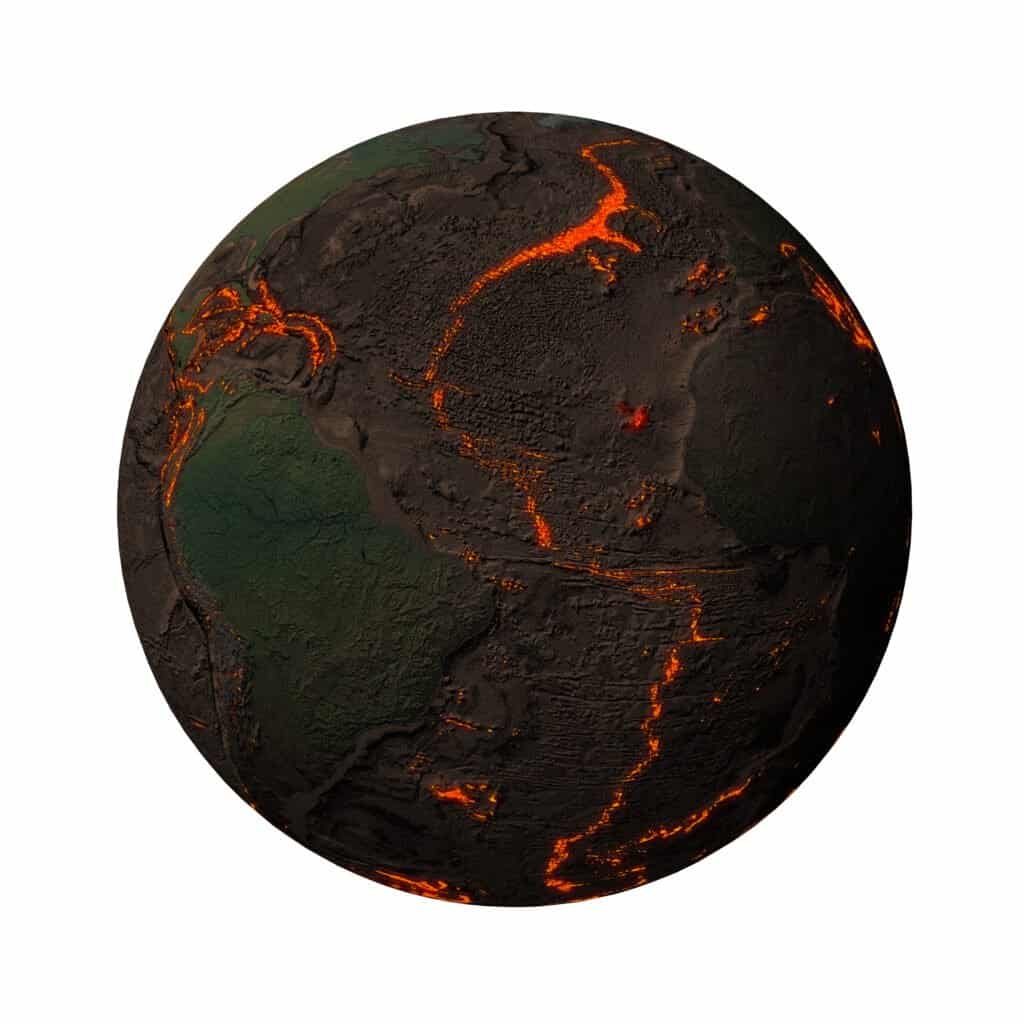
There are hundreds of volcanoes that currently make up the Hawaii archipelago and
six active volcanoes
.
©visdia/Shutterstock.com
Hawaii is an archipelago of the Pacific Ocean. There are fifteen volcanoes that make up the eight prominent islands of Hawaii. It took thousands of years to form into the islands that we know today from that hot spot in the Pacific Ocean.
The tectonic plates that form the earth’s crust moved over magma plumes, thus forming volcanoes that became the islands over time. This is referred to as a “hot spot,” and the trail it left became the Hawaiian islands.
Hawaii has a long-lasting, deep and rich history. This hot spot has likely been shooting out plumes of magma for the last 70 million years
When asking how many volcanoes are in Hawaii, one must consider how complex a question is. Because of the way these volcanoes first form underwater and how many miles deep they can be, there are more than a hundred at least and we can’t honestly know the total number. However, there are some prominent volcanoes in Hawaii that are fascinating to learn about.
Activity of Volcanoes in Hawaii
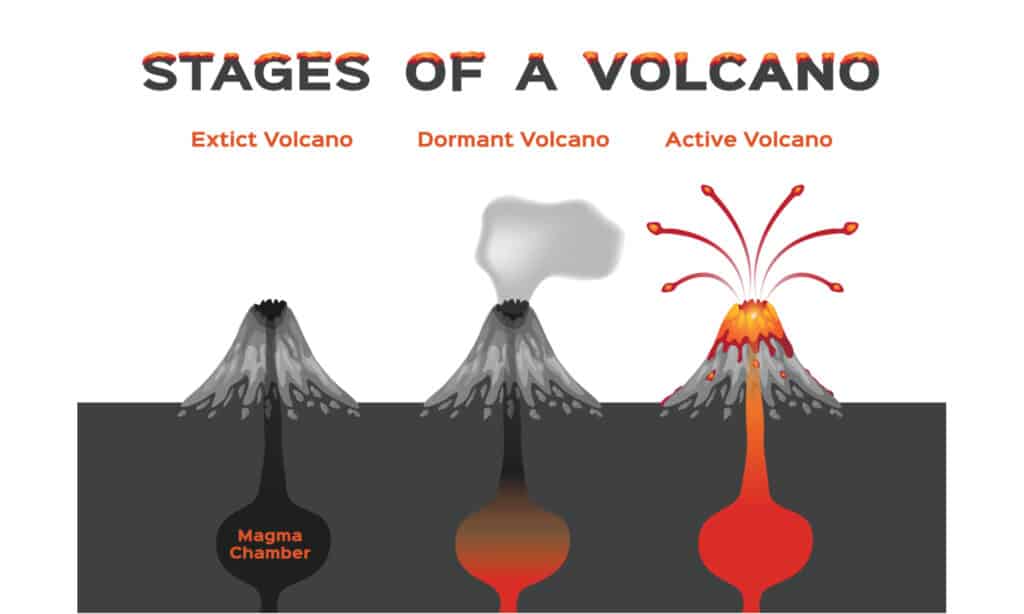
Volcanoes are either active, dormant or extinct.
©gritsalak karalak/Shutterstock.com
There are active volcanoes, which are volcanoes that are known to erupt regularly in this day and age. There are dormant volcanoes, which are volcanoes that have not erupted in the last twenty to one hundred years but still could. Then, there are extinct volcanoes, which are volcanoes that no longer have magma activity and wouldn’t erupt at any point ever again; they’re mountains.
Seamounts are extinct volcanoes located underwater, so they are underwater mountains and no longer spew out lava or have access to magma.
When volcanoes first start to erode away, they are called an atoll island. This is when they grow extinct as they move away from their magma sources. As they sink further and further away, they become atolls.
Once completely underwater, they become seamounts, just underwater mountains no longer capable of creating landmasses.
The Islands of Hawaii
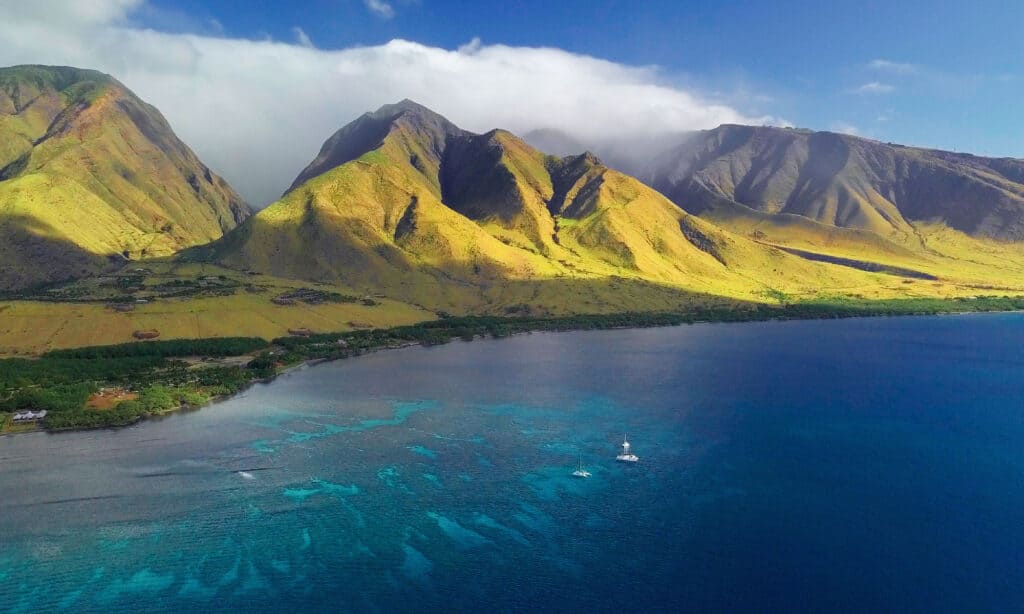
137 total islands make up Hawaii, but there are eight main islands and 15 central volcanoes.
©iStock.com/mihtiander
Eight islands make up the majority of Hawaii, but there are 137 total, and they were all formed by volcanoes. The eight main islands themselves are comprised of their volcanoes. These eight islands are:
- Hawai’i
- Kaua’i
- Koho’olawe
- Lana’i
- Maui
- Moloka’i
- Ni’ihau
- O’ahu
Volcanoes of the Hawaiian Islands
Of these main islands, 15 volcanoes are known to be a part of them. These are the important ones you would think of when discussing Hawaiian volcanoes. These 15 volcanoes include:
- Hawai’i (Big Island)-
- Kilauea
- Mauna Loa
- Mauna Kea
- Hualalai
- Kohala
- Kaua’i-
- Made up of a single volcano, Waialeale.
- Koho’olawe-
- It is the exposed top of a shield volcano, Lua Makika.
- Lana’i-
- Formed by Lanaihale, an extinct volcano.
- Maui-
- Haleakala
- Mauna Kahalawai
- Moloka’i-
- Wailu
- Mauna Loa
- Ni’ihau-
- Made up of a single shield volcano.
- O’ahu-
- Waianae
- Koolau
Kilauea
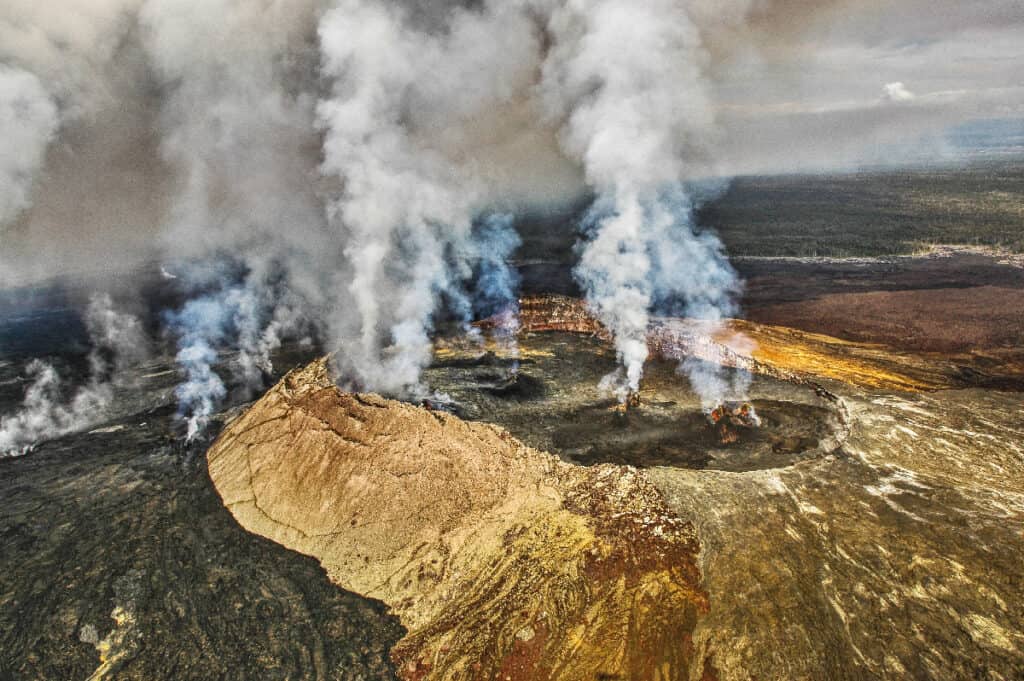
Kīlauea is the most active volcano in the world.
©iStock.com/Vito Palmisano
This is the most active volcano globally and has been actively erupting since 1983, spewing lava out over itself to continue growing. The most recent surge began in the summer of 2021 and has continued onward.
As shield volcanoes grow by spreading outward, the lava cools and hardens into material that eventually turns into a shield-like shape.
Mauna Loa

Mauna Loa covers more than half the Big Island of Hawaii.
©MNStudio/Shutterstock.com
Covering more than half of the island of Hawai’i, this volcano is one of the most prominent volcanoes mentioned in this article. Since 1843 it has had 33 recorded eruptions, though none in recent years.
Mauna Loa is yet another shield volcano, and visitors can hike it and view the world from its point. Everyone is always a little on edge because it is an active volcano.
Mauna Kea
You wouldn’t believe it at first, but this is the highest volcano in the world. To be exact, most of this volcano remains underwater, about 6,000 feet of it. But with 10,000 total feet in height, it truly sets the record.
This volcano is also considered one of the active volcanoes of Hawaii, though that is loose terminology because it has not erupted in thousands of years.
Hualalai
Yet another active volcano, you don’t have to be too worried about going for a hike on this volcano because it hasn’t erupted in more than 200 years. Of course, that means it is due for an eruption any time now.
There was earthquake activity in the vicinity of Hualalai, which just furthers the hypothesis that volcanic activity is incoming. We all better keep our eyes peeled for updates on this volcano.
Kohala
Known as the “sleeping giant,” Kohala is extinct, so you don’t have to worry about any volcanic activity. It is a massive part of what formed the island of Hawaii, and now it is the base for beautiful forests, which have grown on it over the years.
This extinct volcano is not often visited as there are no trails, and the land has grown harsh to traverse, especially to outsiders. The development of this uninhabited land is a testament to the hardiness of nature.
Waialeale
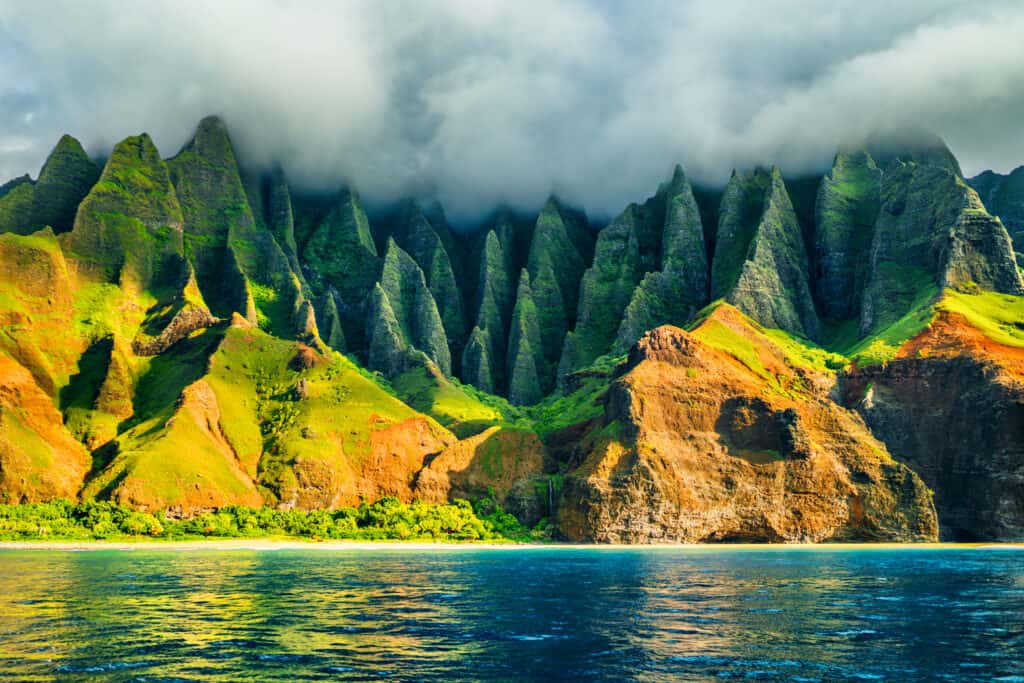
Kauai is made of mountains that used to be volcanoes
©Maridav/Shutterstock.com
The island of Kaua’i is made up of mountains that used to be volcanoes. The height of Waialeale causes winds to become trapped, and for more rain to fall, so it is one of the wettest places in the area.
Waialeale is also a shield volcano, just like the many others we’ve learned about. They are a beautiful example of the earth growing and changing through the years.
Lua Makika
The island of Kaho’olawe is home to the extinct shield volcano of Lua Makika. The island is only 45 miles long, and there are no cities or ports on it. This is just another extinct shield volcano that helped grow the land as we know it today.
This is also a beautiful example of what happens when land remains untouched for generations. The environment is no longer friendly to humans but has thrived without us for the last 1,000 years at the minimum.
Lanaihale
The island of Lana’i was formed around 1.5 million years ago by the volcano dubbed Lanaihale. The island itself is 141 miles wide. There is a thriving community on this island, and it is home to all sorts of activities and community.
By being an extinct volcano, there are no worries that it could harm current-day communities, and that must be a relief to the residents who live there.
Haleakala
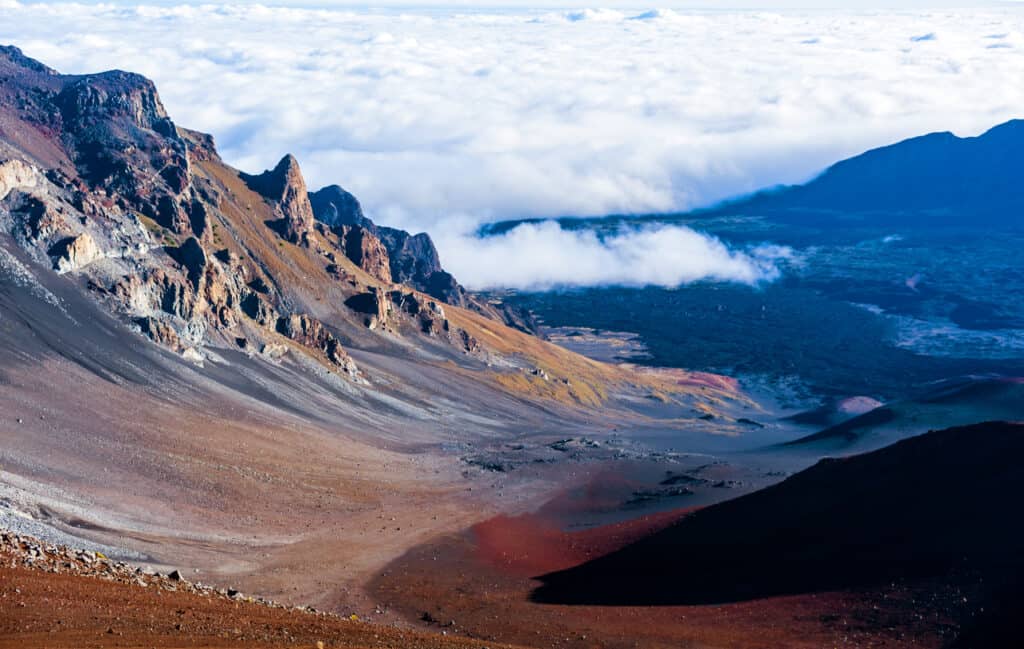
View of the Haleakalā volcano summit , island of Maui, Hawaii
©iStock.com/sphraner
The island of Maui has two well-known volcanoes on it, and one of them is Haleakala. Yet another shield volcano, Haleakala, is famous because its erosion has led to the largest volcanic crater in the world. It is 2,600 feet deep and can be accessed by well-worn trails for the hardiest of travelers.
Mauna Kahalawai
Also known as the West Maui Mountain, this is the brother mountain to Haleakala. This shield volcano looks more mountainous now than it does a volcano, which is ironic when comparing it to the other Maui Mountain.
Ni’ihau
Ni’ihau is made up of a single, lonely little shield volcano that has long been extinct. It has crumbled and eroded away into the ocean. The island is populated by people who do not need to fear volcanic activity.
Not many people can visit this island as it is very isolated, and you likely need to have relational ties to the inhabitants if you want to go there.
Waianae
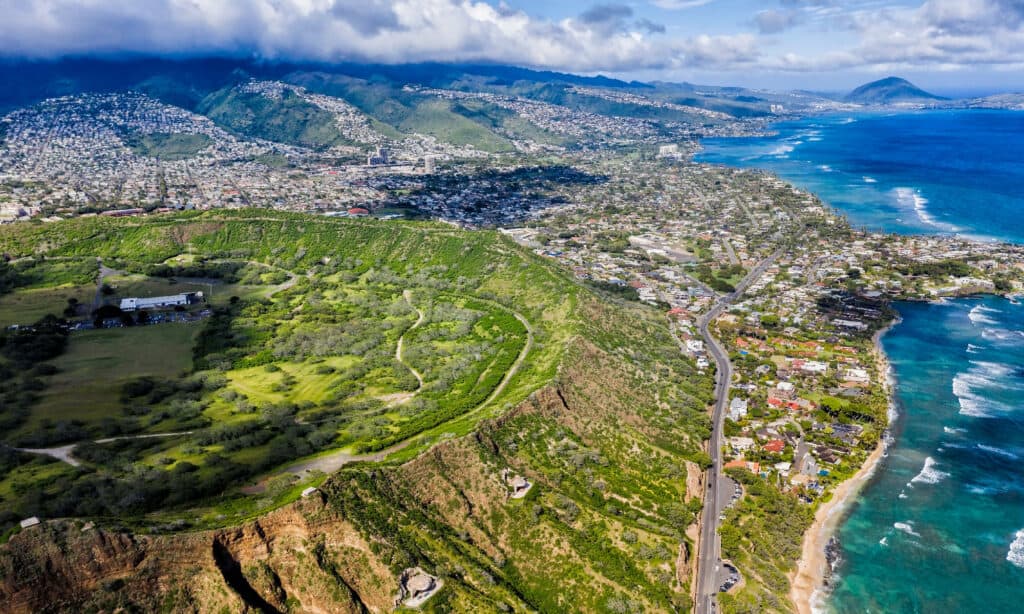
The two volcanoes Waianae and Koolau are on the main island of Oahu and have not erupted for more than 2.5 million years.
©iStock.com/marchello74
The island of O’ahu is perhaps the most well-known of the Hawai’i islands, and that is because it has the most activity on the island and in the waters surrounding it. This volcano has not erupted for more than 2.5 million years.
Koolau
The other volcano on O’ahu, this one also has not erupted for more than 2.5 million years.
It makes sense that O’ahu would be the most inhabited island with the most diverse sea life and activity around because it’s had more time to develop again after the lava flows stopped.
No matter where you go in Hawaii, there is a rich history and geography to explore. Volcanoes are a mystifying example of nature’s resilience.
The photo featured at the top of this post is © Yvonne Baur/Shutterstock.com
Thank you for reading! Have some feedback for us? Contact the AZ Animals editorial team.






